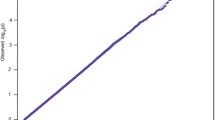En
Summary]This study aimed to test the effects of five single nucleotide polymorphisms within SLC2A9 on uric acid level in a special ethnic population, the Uygurs in Xinjiang, China. According to our inclusion and exclusion criteria, Uygur adults from Xinjiang constituted the study population. There were 1053 Uygur adults with hyperuricemia and 1373 normal Uygur adults who served as controls. Five single nucleotide polymorphisms within SLC2A9 (rs938557, rs7679916, rs7349721, rs13101785, and rs13137343) were selected with the HapMap dataset and TaqMan assays. We found that, in normouricemia group, rs938557 was significantly correlated with uric acid (β=11.39±3.74, P=0.0024) adjusting for age, gender and BMI; rs7679916 and rs13137343 were marginally associated with uric acid concentration (β=5.77±3.09, P=0.0626; β= 5.99±3.08, P=0.0520). In the hyperuricemia group, no SNP was found to possibly influence uric acid concentration. None of these SNPs showed significant association with hyperuricemia after controlling for age, gender and BMI. There were significant or marginal correlations between certain single nucleotide polymorphisms in the SLC2A9 region and uric acid concentration in Uygur normouricemia samples. In turn, some of these single nucleotide polymorphisms in SLC2A9 may increase the risk of hyperuricemia.
Similar content being viewed by others
References
Ciarla S, Struglia M, Giorgini P, et al. Serum uric acid levels and metabolic syndrome. Arch Physiol Biochem, 2014,120(3):119–122
Gustafsson D, Unwin R. The pathophysiology of hyperuricaemia and its possible relationship to cardiovascular disease, morbidity and mortality. BMC Nephrol, 2013,14:164
Liu B, Wang T, Zhao HN, et al. The prevalence of hyperuricemia in China: a meta-analysis. BMC Public Health, 2011,11:832
Rho YH, Zhu Y, Choi HK. The epidemiology of uric acid and fructose. Semin Nephrol, 2011,31(5):410–419
Anzai N, Kanai Y, Endou H. New insights into renal transport of urate. Curr Opin Rheumatol, 2007,19(2):151–157
Bobulescu IA, Moe OW. Renal transport of uric acid: evolving concepts and uncertainties. Adv Chronic Kidney Dis, 2012,19(6):358–371
Fathallah-Shaykh SA, Cramer MT. Uric acid and the kidney. Pediatr Nephrol, 2014,29(6):999–1008
Charles BA, Shriner D, Doumatey A, et al. A genome-wide association study of serum uric acid in African Americans. BMC Med Genomics, 2011,4:17
Sun X, Jiang F, Zhang R, et al. Serum uric acid levels are associated with polymorphisms in the SLC2A9, SF1, and GCKR genes in a Chinese population. Acta Pharmacol Sin, 2014,35(11):1421–1427
Li C, Chu N, Wang B, et al. Polymorphisms in the presumptive promoter region of the SLC2A9 gene are associated with gout in a Chinese male population. PLoS One, 2012,7(2):e24561
Hamburger M, Baraf HS, Adamson TC 3rd, et al. 2011 recommendations for the diagnosis and management of gout and hyperuricemia. Phys Sportsmed, 2011,39(4):98–123
Caulfield MJ, Munroe PB, O’Neill D, et al. SLC2A9 is a high-capacity urate transporter in humans. PLoS Med, 2008,5(10):e197
Lipkowitz MS. Regulation of uric acid excretion by the kidney. Curr Rheumatol Rep, 2012,14(2):179–188
Reginato AM, Mount DB, Yang I, et al. The genetics of hyperuricaemia and gout. Nat Rev Rheumatol, 2012,8(10):610–621
Kolz M, Johnson T, Sanna S, et al. Meta-analysis of 28,141 individuals identifies common variants within five new loci that influence uric acid concentrations. PLoS Genet, 2009,5(6):e1000504
Yang Q, Kottgen A, Dehghan A, et al. Multiple genetic loci influence serum urate levels and their relationship with gout and cardiovascular disease risk factors. Circ Cardiovasc Genet, 2010,3(6):523–530
Li S, Sanna S, Maschio A, et al. The GLUT9 gene is associated with serum uric acid levels in Sardinia and Chianti cohorts. PLoS Genet, 2007,3(11):e194
Wallace C, Newhouse SJ, Braund P, et al. Genome-wide association study identifies genes for biomarkers of cardiovascular disease: serum urate and dyslipidemia. Am J Hum Genet, 2008,82(1):139–149
Cui Y, Duan R, Zhou H, et al. Analysis of genetical structure of the ancient Xinjiang population. Gao Deng Xue Xiao Hua Xue Xue Bao (Chinese), 2002,23,2278–2280
Miao PS. Ethnic Amalgamation in the Brim Area of the Tarim Basin and the Emerging and Development of Uygur Nationality. Xi Yu Yan Jiu (Chinese), 2005,4
Yao H, Sun YP, Wang QY. Correlation of serum uric acid levels and glycerin, lipid metabolic abnormality in Han and Uygur ethnicity. Xin Jiang Yi Ke Da Xue Xue Bao (Chinese), 2007,30(6):539–542
Cai W, Wu X, Zhang B, et al. Serum uric acid levels and non-alcoholic fatty liver disease in Uyghur and Han ethnic groups in northwestern China. Arq Bras Endocrinol Metabol, 2013,57(8):617–622
Mayina C, Zhang W, Zhang B, et al. The ethnic heterogeneity of uric acid level and hyperuricemia. Zhong Guo Wei Sheng Jian Yan Za Zhi (Chinese), 2013,23:963–965
Acknowledgements
We would like to thank all of the participants, individuals and institutions that supported this study.
Author information
Authors and Affiliations
Corresponding authors
Additional information
This study was supported by grants from the National Natural Science Foundation of China (No. 81560153 and No. 81760169), the Natural Science Foundation of the Xinjiang Uygur Autonomous Region (No. 2017D01C234), and the Open Project of Shanghai Six People’ Hospital and Shanghai Key Laboratory of Diabetes Mellitus (No. SHKLD-KF-1502)
Conflict of Interest Statement
The authors declare that there is no conflict of interest with any financial organization or corporation or individual that can inappropriately influence this work.
Rights and permissions
About this article
Cite this article
Sun, Yp., Xu, Fl., Yan, Dd. et al. Association between SLC2A9 Genetic Variants and Risk of Hyperuricemia in a Uygur Population. CURR MED SCI 39, 243–249 (2019). https://doi.org/10.1007/s11596-019-2026-2
Received:
Revised:
Published:
Issue Date:
DOI: https://doi.org/10.1007/s11596-019-2026-2




